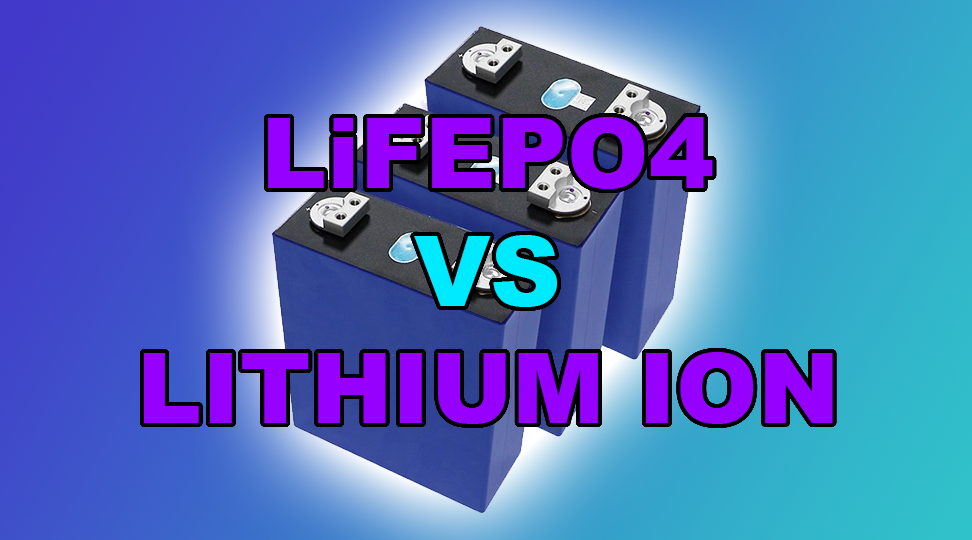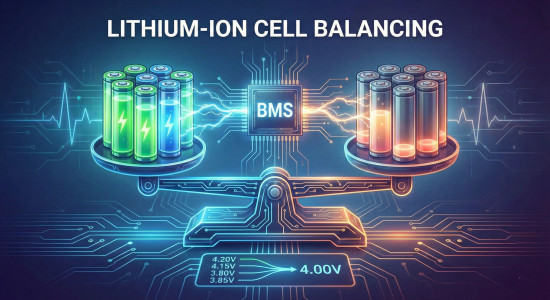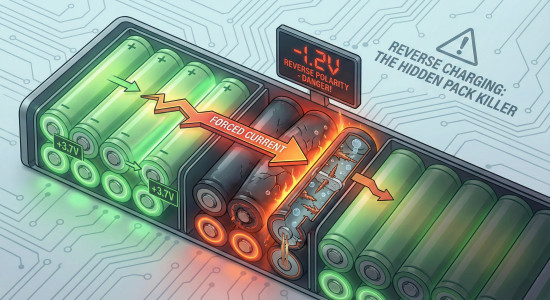
LFP vs. NMC: The Real “Lithium-ion vs. Lithium-ion” Battery Comparison
Table of Contents
- Introduction: Why the Framing Is Wrong
- The Misconception in Search Results
- Examples of How the Confusion Spreads
- Getting It Right: The Simple Definition
- Energy Density: Size and Weight Trade-offs
- Cycle Life: Longevity Wins for LFP
- Thermal Stability and Safety
- Cost and Materials
- Cold-Weather Performance
- Charge Rate and Fast Charging
- Calendar Aging and State of Charge
- Best-Fit Applications
- Practical Guidance and Decision Points
- Conclusion
LFP vs. NMC: Clearing Up the “Lithium-ion vs. Lithium-ion” Confusion
Introduction: Why the Framing Is Wrong
If you Google “lithium-ion versus LiFePO₄” right now, you’ll often see an AI-generated overview that says LiFePO₄ (lithium iron phosphate) and lithium-ion batteries are both rechargeable but differ in safety, lifespan, energy density, and cost. The problem starts right there: LiFePO₄ is a subset of lithium-ion.
The “L” in LiFePO₄ stands for lithium, and the “Fe” stands for iron.
What people usually mean by “lithium-ion versus LFP” is NMC (nickel-manganese-cobalt) lithium-ion versus LFP lithium-ion. In other words: NMC vs. LFP—two chemistries under the same lithium-ion umbrella. This distinction isn’t pedantic; it’s foundational for making good technical and purchasing decisions. A clear taxonomy keeps comparisons fair and context-appropriate.
The Misconception in Search Results
What’s supposed to be a high-quality answer from a trusted provider at the top of a results page can wind up nonsensical without this context. The very first thing that response should say is that LiFePO₄ batteries are a type of lithium-ion battery. When people say “lithium-ion versus LFP,” or “LFP versus lithium-ion,” they usually mean NMC vs. LFP—lithium-ion vs. lithium-ion with different cathode chemistries.
Saying “LFP vs. lithium-ion” is like asking, “What’s better, a Ford or a truck?” A truck is a category of vehicle. Ford makes models of trucks you might like. Using precise terms avoids apples-to-oranges answers and helps consumers evaluate trade-offs realistically.
Examples of How the Confusion Spreads
Scroll past the AI blurb and Reddit and you might see brand articles titled along the lines of “LiFePO₄ vs. Lithium-ion: What’s the Best Choice?” The title is understandable for SEO, but the article should explicitly say that LFP is a subset of lithium-ion. Too often, it doesn’t.
One piece opens with, “The LFP battery type has come down in price in recent years and its efficiency has dramatically improved.
It’s surpassing lithium-ion as the battery of choice for many applications, including off-grid and solar power and even electric vehicles.” It continues, “LiFePO₄ batteries are similar to ion but have significant advantages that make them the ideal option for consumer-grade backup power solutions.” This kind of language glosses over the fact that LFP is lithium-ion, and it treats “lithium-ion” as if it meant only NMC. This gives in to the misconception instead of correcting it, which misleads readers and muddies technical understanding.
Getting It Right: The Simple Definition
The information is out there and easy to state clearly. For example, a correct first sentence would be: “The lithium iron phosphate (LiFePO₄, or LFP) battery is a type of lithium-ion battery that uses lithium iron phosphate as the cathode material.” That’s it. Once this foundation is set, meaningful comparisons can follow.
Clear definitions make the rest of the discussion straightforward: you’re comparing two lithium-ion chemistries, not lithium-ion vs. something else. From here, we can fairly evaluate LFP vs. NMC on the metrics that matter.
Energy Density: Size and Weight Trade-offs
LFP: About 90–160 Wh/kg. You’ll need a larger, heavier pack for the same kWh.
NMC: About 150–250 Wh/kg. More energy per kilogram yields more range or smaller packs for the same capacity.
Cycle Life: Longevity Wins for LFP
LFP: “1,500 to 3,000 cycles before there is 80% capacity loss.” (Clarification: commonly understood as reaching ~80% of original capacity, i.e., ~20% capacity loss.) That’s tremendous cycle life in practical use.
NMC: Roughly 500 to 1,000 cycles under gentle use.
Longer cycle life can dominate total cost of ownership for stationary storage and daily-cycle use cases. This is why LFP is so attractive for home batteries and off-grid systems.
Thermal Stability and Safety
LFP: Excellent thermal stability with a much lower risk of thermal runaway. More tolerant to heat and abuse.
NMC: Relatively stable for its power density, but significantly more sensitive to abuse and heat. A BMS (Battery Management System) is absolutely required.
Safety isn’t only about catastrophic failure; it’s also about predictable behavior under stress. LFP’s chemistry provides a wider safety margin, especially in less controlled environments.
Cost and Materials
LFP: Cells are cheaper to build. Cathodes use abundant iron and phosphate—no nickel or cobalt—so material costs and supply risks are lower.
NMC: Pricier and exposed to volatile nickel and cobalt markets.
Material choice influences not just price but also supply chain resilience and ethical sourcing considerations, which many buyers now factor into procurement.
Cold-Weather Performance
LFP: The loser here. Charging below 0 °C requires preheating the pack and limiting charge current (via the charge controller or BMS) to avoid damage.
NMC: Better low-temperature performance than LFP, though still requires care—just at higher temperatures.
If you operate in harsh winters without reliable preconditioning, chemistry matters. Cold derates are real and can define the user experience.
Charge Rate and Fast Charging
LFP: Typically can’t charge as fast as NMC.
NMC: Can charge extremely fast, but careful thermal management is critical to prevent overheating.
Infrastructure, duty cycle, and thermal design dictate whether fast charging is a must-have or a nice-to-have. Pick the chemistry that aligns with your charging reality.
Calendar Aging and State of Charge
LFP: More resilient to calendar aging and can sit at a high state of charge with less degradation.
NMC: Less tolerant of sustained high voltage/SoC; storing at high SoC accelerates aging.
If your asset spends long periods parked or idling at high charge, LFP’s calendar-life traits can translate into years of extra useful life.
Best-Fit Applications
LFP excels when size is not paramount: grid storage, home batteries, buses, short-range EVs, and systems where safety, cycle life, and $/kWh dominate.
NMC shines where space and power density rule: long-range EVs, high-performance vehicles, and tightly packaged applications.
Application fit is about constraints: volume, mass, thermal budget, duty cycle, climate, and charging profile. Map those constraints to the chemistry’s strengths.
Practical Guidance and Decision Points
- Max range / smallest pack: Choose NMC.
- Longest overall life, highest safety margin, lowest $/kWh (cell level): Choose LFP, accepting a larger pack.
- Extremely cold climates with limited preconditioning: NMC is often the better choice.
- Daily fast charging and frequent high SoC storage with longevity goals: LFP is the safer bet.
Framing the choice this way—NMC lithium-ion vs. LFP lithium-ion—keeps the conversation technically honest. It prevents the “Ford vs. truck” problem and leads to better-informed decisions.
Conclusion
The core mistake in many “LFP vs. lithium-ion” pieces is category confusion. LFP is lithium-ion. The real comparison most people want is NMC vs. LFP. Once that’s clear, the trade-offs line up: NMC for energy and power density; LFP for safety, longevity, and cost stability. Precise language isn’t nitpicking—it’s how we avoid misleading readers and how we choose the right battery for the job.


